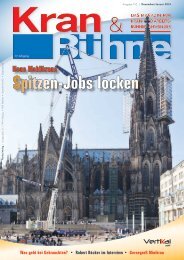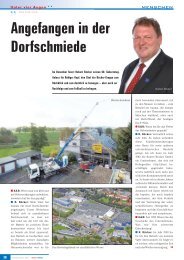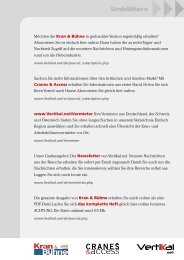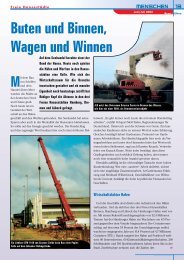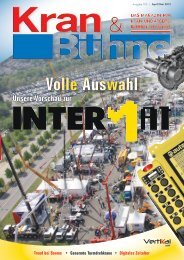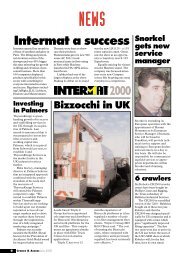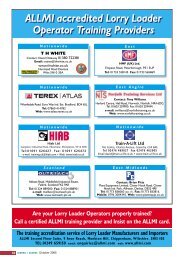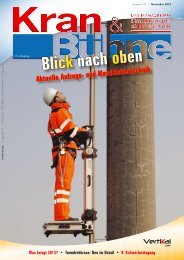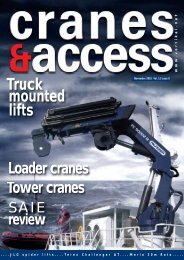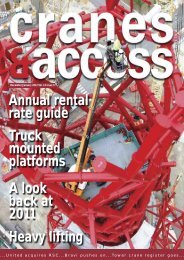Crawler - Vertikal.net
Crawler - Vertikal.net
Crawler - Vertikal.net
Create successful ePaper yourself
Turn your PDF publications into a flip-book with our unique Google optimized e-Paper software.
New US crane<br />
rules mandate<br />
operator certification<br />
The US Crane & Derricks in Construction Final Rule<br />
has finally been published. A four year transition<br />
period begins in mid-November before all sections<br />
effectively become law.<br />
The US Department of Labor says that the new rules will affect around<br />
257,000 businesses and 4.8 million workers, and are intended to reduce<br />
crane fatalities on construction sites in the USA which are thought to be<br />
around 100 a year. The Department estimates that the new standards will<br />
save 22 lives and yield a saving for the economy of $55 million a year after<br />
allowing for the costs of implementation.<br />
Key changes include:<br />
Operator certification and training<br />
All (construction related)<br />
employees working with cranes,<br />
including riggers, signalmen<br />
oilers etc will need to have had<br />
proper training and be qualified<br />
or declared competent for the job<br />
they carry out, while crane<br />
operators will also need to be<br />
independently certified for the<br />
specific crane type.<br />
New rules for overhead power lines<br />
The standard includes a large<br />
section on working near or under<br />
or driving under overhead power<br />
lines with strict details of safe<br />
distances and work practices that<br />
must be followed.<br />
Tower crane inspections<br />
Tower crane components must<br />
now be fully inspected<br />
immediately prior to the crane<br />
being erected.<br />
Ground conditions and outriggers<br />
The standard goes into<br />
considerable detail on ground<br />
conditions and outrigger or<br />
stabiliser set-up and the need<br />
to understand ground conditions.<br />
The new rules also place greater<br />
responsibilities on general<br />
contractors. For example, they will<br />
now be obliged to inform anyone<br />
working with a crane on site of the<br />
presence of any underground voids<br />
or poor ground conditions.<br />
A full report and comment, along<br />
with the full text of the new rules<br />
is now available for download<br />
from the library section of<br />
www.vertikal.<strong>net</strong><br />
All crane operators will need to<br />
be certified by 2014<br />
Who<br />
trained<br />
him<br />
then?<br />
c&a<br />
training<br />
Liebherr GB adds<br />
crawler crane training<br />
Liebherr Great Britain’s CPCS accredited training school is now<br />
offering crawler crane (A02) operator training and testing.<br />
The training centre - located at the company’s Biggleswade, Bedfordshire,<br />
headquarters - has expanded its curriculum to include both CPCS and<br />
Liebherr’s own certification. The new courses, which can also be held at<br />
customer’s premises, have been created specifically to provide certified<br />
compliance for lifting operations and lifting equipment requirements in<br />
accordance with British Standards for the safe use of cranes.<br />
Lack of training costs<br />
£25,000 plus…<br />
Two brothers have been hit with £25,000 in fines and costs, while a<br />
young employee has been left severely handicapped, following a fall<br />
during demolition work.<br />
Alan Hind, 28, was helping to demolish an<br />
industrial building in Carlisle when he fell six<br />
metres to the concrete floor below permanently<br />
damaging his sight and hearing.<br />
The Health and Safety Executive prosecuted<br />
Robert and Eric Murray following the incident<br />
at Watts Yard on London Road in Carlisle on<br />
27th February 2008. In the fall, Hind suffered<br />
16 skull fractures, broke his jaw in three places,<br />
fractured his wrist, damaged a kidney and is<br />
Alan Hind, 28, was<br />
severely injured in the fall<br />
now deaf in his right ear and blind in his left eye. Parts of his brain were so<br />
badly damaged that they had to be removed. He has also had to wait six<br />
months for a titanium plate to be inserted into his damaged skull.<br />
Eric Murray, trading as E.J. Murray (Steel Structures), was prosecuted for<br />
breaching Regulation 6(3) of the Work at Height Regulations 2005 by<br />
failing to take measures to prevent workers falling and being injured.<br />
Robert Murray, trading as Murray Structures, pleaded guilty to breaching<br />
Regulation 5 of the Work at Height Regulations 2005 by not hiring trained<br />
workers and failing to ensure the work was planned and carried out safely.<br />
David Charnock, HSE construction inspector in Cumbria, said: “Mr Hind is<br />
lucky to be alive following his fall, which could and should have been<br />
prevented. He sustained multiple injuries which will affect him for the rest<br />
of his life. Unfortunately neither Robert nor Eric Murray took the necessary<br />
safety precautions. The workers they employed were casual labourers and<br />
did not have the skills or experience to work on industrial roofs. As this<br />
incident demonstrates, carrying out work at height can result in serious<br />
injury and even death if not properly planned. Steps must be taken to<br />
prevent people falling, and everyone involved in the work must be properly<br />
trained.”<br />
Robert Murray was fined £8,000 plus £4,000 towards the cost of the<br />
prosecution, while Eric Murray was fined £5,000 plus costs of £8,000.<br />
August/September 2010 cranes & access 57



